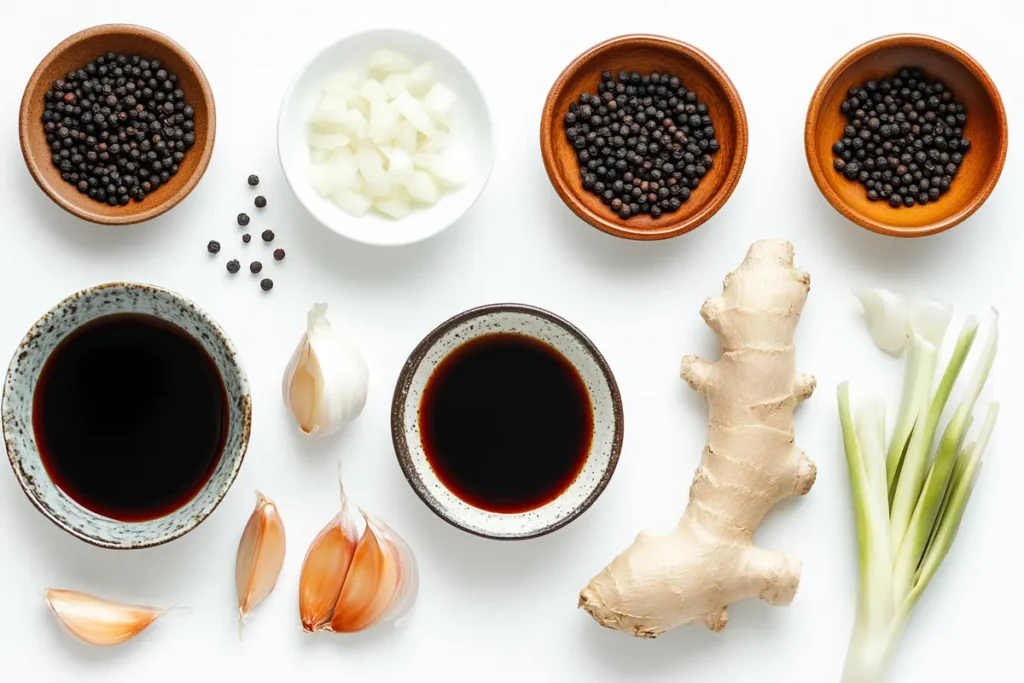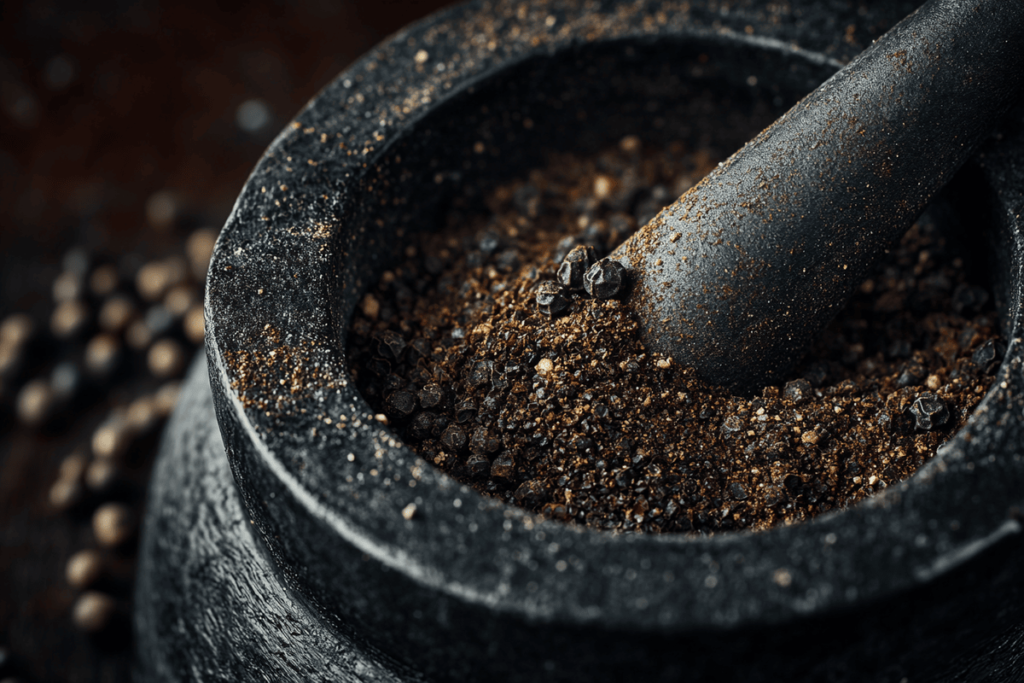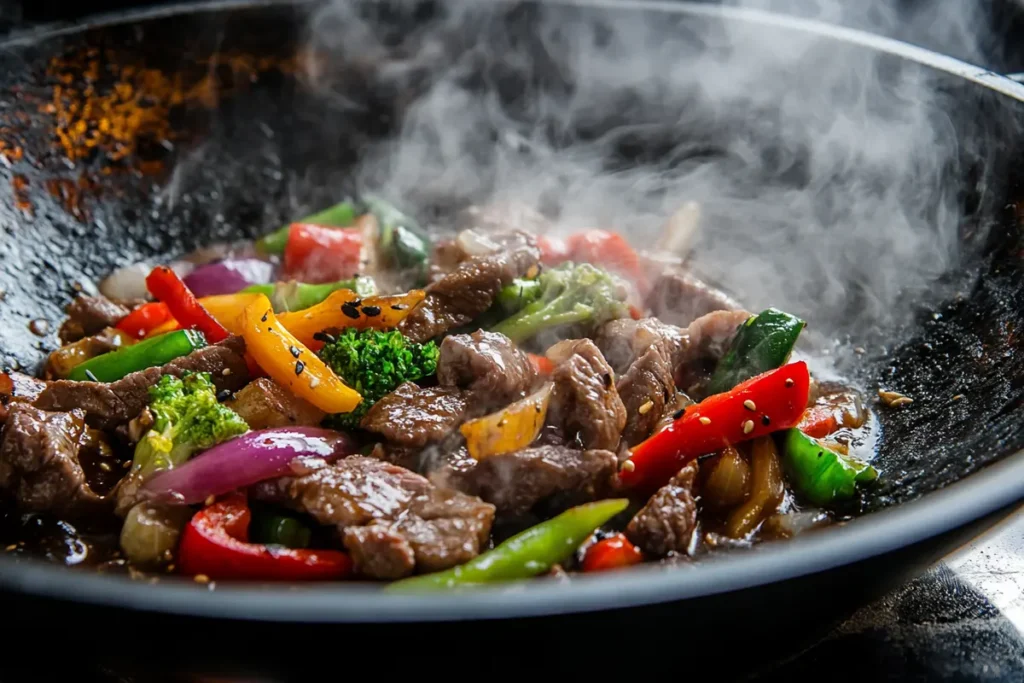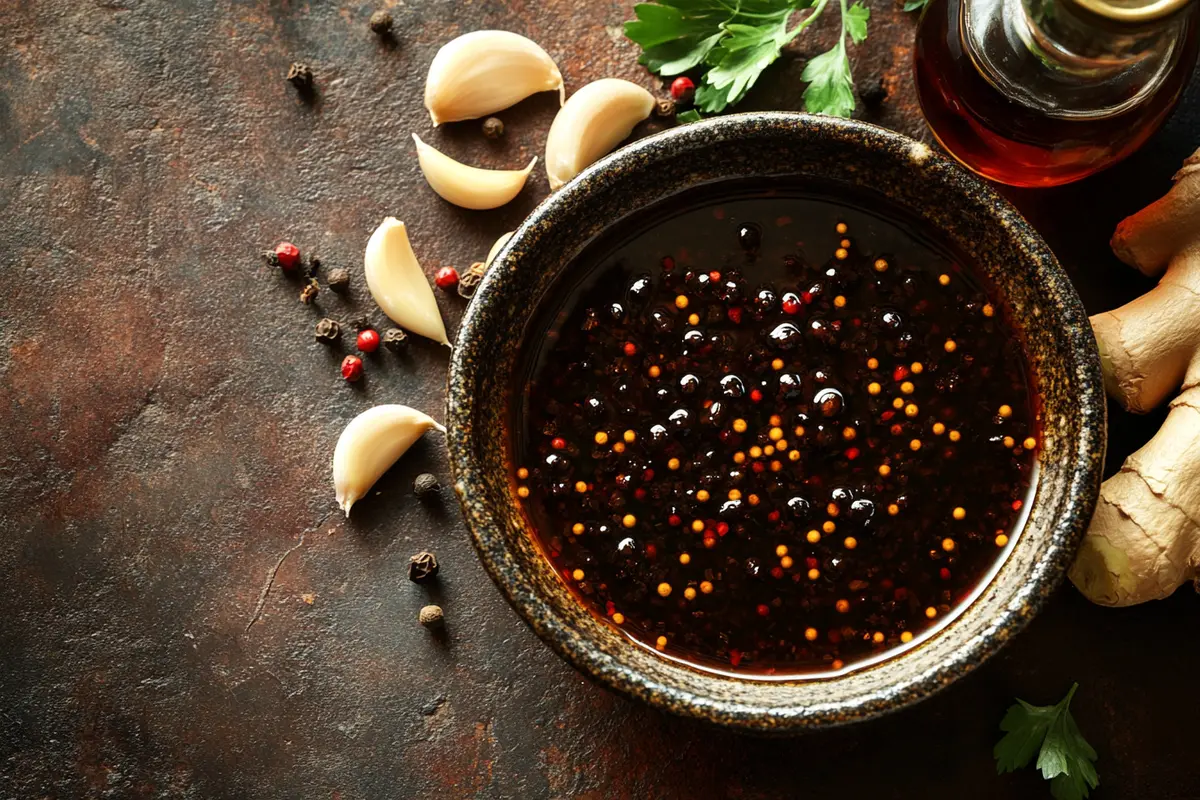What is Chinese black pepper sauce made of? Many people who enjoy stir-fry dishes, Asian-inspired marinades, and bold flavors often ask this question. Chinese black pepper sauce brings a distinct, savory taste to many wok-based recipes. Its deep, rich aroma and subtle heat have made it a favorite in American kitchens, especially as more home cooks explore Asian cuisines.
Introduction: The Allure of Chinese Black Pepper Sauce
Chinese black pepper sauce stands out for its distinctive balance of spiciness and umami. It often appears in stir-fry recipes featuring beef, chicken, or vegetables. The sauce’s appeal lies in its ability to elevate simple ingredients into complex, flavorful dishes. Therefore, What is Chinese black pepper sauce made of? Primarily, it combines ground black pepper, savory base sauces like soy sauce, aromatic elements like garlic and onion, and occasionally other seasonings. Each component works together to produce a layered flavor profile that enhances many dishes.
Core Ingredients: A Breakdown of Flavors
What is Chinese black pepper sauce made of? At its heart, this sauce focuses on a few simple yet powerful ingredients:
- Black Pepper: Freshly ground black pepper gives the sauce its signature heat and aroma.
- Soy Sauce: A salty, umami-rich base that deepens flavor.
- Garlic and Ginger: Aromatics that add warmth, fragrance, and subtle spice.
- Onions or Shallots: They introduce sweetness and a savory depth.
- Sugar or Honey (Optional): A hint of sweetness can balance the pepper’s bite.
- Cornstarch Slurry: Used as a thickener, it gives the sauce a smooth consistency.
- Broth or Water: A neutral liquid base that adjusts thickness and flavor intensity.

The Importance of Black Pepper
Black pepper is a cornerstone ingredient. High-quality peppercorns, freshly ground, release aromatic oils that shape the sauce’s character. When you ask, What is Chinese black pepper sauce made of? the pepper is central. It provides the signature spicy kick. Unlike chili-based heat, black pepper’s warmth is subtle and earthy. It blends well with soy sauce and aromatics, creating a balanced heat that never overwhelms.
For best results, consider using whole peppercorns. Crush them just before cooking. This step preserves their intensity. The difference between pre-ground pepper and freshly ground pepper is significant. Fresh pepper offers a brighter, sharper flavor. Furthermore, the aroma can influence how your final dish tastes. Therefore, invest in good-quality peppercorns to ensure a superior sauce.

Balancing Umami and Sweetness
Chinese black pepper sauce not only focuses on heat. It also embraces umami, that savory taste found in soy sauce and sometimes oyster sauce. Umami provides depth and complexity. It makes dishes rich and satisfying. However, to balance the bold flavors, a hint of sweetness often appears. This sweetness can come from sugar, honey, or even caramelized onions.
For example, if you find the sauce too salty or bitter, add a small amount of sugar. The result is a more rounded profile. In addition, sweetness tames the pepper’s sharp bite, making the sauce enjoyable even for those who prefer milder flavors. The key is moderation. Taste as you go and adjust the seasoning to achieve harmony.
Aromatics: Garlic, Ginger, and More
Aromatics like garlic and ginger play a vital role in Chinese cooking. They add fragrance, depth, and complexity. In black pepper sauce, these aromatics brighten the overall flavor. For instance, garlic provides a pungent, savory note that enhances the pepper’s spice. Ginger, on the other hand, introduces a subtle zing and fresh quality.
Shallots or onions can also join the party. Their natural sweetness mellows the robust flavors and adds body to the sauce. When combined, these ingredients create a foundation that supports the pepper’s starring role. Therefore, never underestimate the value of aromatics. They transform a simple sauce into something memorable.
Thickening Agents and Sauce Texture
A proper Chinese black pepper sauce has a smooth, clingy texture that coats each bite of meat or vegetables. Cornstarch slurry usually achieves this effect. By mixing a small amount of cornstarch with water, then adding it to the sauce, you instantly create a glossy finish. This thickening agent ensures the sauce adheres to the dish, delivering flavor in every bite.
In addition, controlling consistency matters. If the sauce is too thin, it won’t stick. Too thick, and it might feel heavy. Adjusting the cornstarch ratio or adding a splash of broth helps. As you cook more often with this sauce, you’ll learn to find your preferred thickness. The goal is a balanced texture that enhances each ingredient without overwhelming it.
Regional Variations and Adaptations
Chinese cuisine is diverse, and black pepper sauce recipes can vary by region. For example, Cantonese versions might lean on oyster sauce for richness. Meanwhile, other regional recipes might emphasize ginger or add a hint of chili paste. In addition, some modern adaptations include a dash of sesame oil for a nutty finish.
Because What is Chinese black pepper sauce made of? doesn’t have one fixed answer, home cooks have freedom. Experiment with different flavor boosters to find your ideal combination. By exploring regional variations, you open doors to new taste experiences. Each tweak can create a distinct profile that suits your palate.
How to Use Chinese Black Pepper Sauce in Cooking
Chinese black pepper sauce is incredibly versatile. It pairs well with various proteins and vegetables. For example, toss it with sliced beef, bell peppers, and onions for a quick stir-fry. Add it to chicken and mushrooms for a savory, aromatic dish. Use it as a marinade for steak or stir it into noodles for a peppery twist.
In addition, consider experimenting with tofu or tempeh for a plant-based take. The sauce’s robust flavors complement earthy vegetables like broccoli or bok choy. Meanwhile, shrimp or scallops also pair nicely, especially when combined with crunchy vegetables. This flexibility ensures that once you’ve mastered the sauce, you can enjoy countless culinary creations.

Pairing With Other Dishes
Chinese black pepper sauce often acts as the star of a dish. However, it also plays well with others. Serve it alongside plain white rice or fried rice to balance its boldness. A mild soup or a light side dish can round out the meal. In addition, consider pairing it with pickled vegetables or a simple cucumber salad to add freshness and contrast.
If you have related recipes on your website, now is a great time to direct readers to them. For instance, if your [website’s sitemap](Insert your website sitemap URL here) includes a popular stir-fry recipe, link to it. This helps your audience discover more ways to incorporate Chinese black pepper sauce into their meals. By combining different components, you create a complete and satisfying dining experience.
Storing and Reheating the Sauce
If you make a batch of Chinese black pepper sauce in advance, proper storage matters. Keep it in an airtight container in the refrigerator. It should stay fresh for up to a week. When reheating, do so gently over low heat. If the sauce thickens in the fridge, add a splash of water or broth to restore its original consistency.
In addition, consider freezing the sauce in small portions if you cook for one. This approach lets you enjoy fresh sauce without making a new batch every time. Proper storage ensures you always have a quick flavor boost on hand.
Making Chinese Black Pepper Sauce at Home
Creating Chinese black pepper sauce at home is simple. Start with basics:
- Mince garlic and ginger.
- Grind fresh black pepper.
- Combine soy sauce, a pinch of sugar, and a bit of oyster sauce if desired.
- Add minced aromatics and simmer briefly.
- Whisk in cornstarch slurry to thicken.
- Taste and adjust seasoning.
In just a few steps, you have a homemade sauce that rivals restaurant quality. This hands-on approach ensures you control the flavor balance. You can also customize heat and sweetness. As you gain experience, you’ll find the perfect ratio of pepper, soy, and sweetener that suits your taste buds.
Incorporating Authentic Techniques
While the recipe is straightforward, incorporating authentic Chinese cooking techniques adds depth. For example, “wok hei” or “breath of the wok” is a concept where intense heat transforms flavors. When you add the black pepper sauce to a hot wok with protein and vegetables, the heat sears and intensifies the sauce. This creates a smoky, complex flavor that enhances the final dish.
If you lack a wok, use a heavy skillet. Heat it until very hot before adding oil, aromatics, and ingredients. The key is quick cooking over high heat, which locks in flavors. Mastering this technique lets you replicate the textures and aromas found in authentic Chinese restaurants.
Using Quality Ingredients
Because What is Chinese black pepper sauce made of? emphasizes a few core elements, ingredient quality matters. Choose a high-quality soy sauce with a rich, balanced flavor. Look for fresh garlic and ginger rather than using powders. Invest in premium peppercorns.
Freshness ensures your sauce tastes vibrant, not dull. Good ingredients produce a sauce that tastes more authentic. Moreover, when your building blocks are top-notch, you need fewer additional seasonings to achieve complexity. Taste your sauce frequently as you cook to ensure it matches your standards.
Serving Suggestions
Chinese black pepper sauce pairs well with many dishes. Try spooning it over a bed of steamed jasmine rice. Serve it with a side of stir-fried bok choy or snow peas. Add a bowl of light soup to complete the meal. For a party, use the sauce as a dip for skewered grilled meats or tofu.
If you run a recipe site, connect your readers to other compatible dishes on your website. For instance, if you have a popular “Simple Vegetable Stir-Fry” recipe in your [website’s sitemap](Insert your website sitemap URL here), include a link. Encouraging readers to explore related recipes broadens their culinary horizons.
Presentation and Garnishing
Presentation matters. Drizzle the sauce over neatly sliced meat and vibrant vegetables. Garnish with fresh scallions or cilantro for a pop of color. Sprinkle a bit of crushed black pepper on top. Simple touches enhance the appeal of the dish.
If plating for guests, serve in attractive dishes. Consider using chopsticks and small dipping bowls for an authentic feel. These small details contribute to the overall dining experience.
Cultural Background
Chinese black pepper sauce, while not as historic as certain classic Chinese sauces, still reflects Chinese culinary principles. It respects balance and harmony. Chinese cuisine values the interplay of sweet, sour, salty, bitter, and umami flavors. Black pepper sauce highlights these concepts by bringing heat, depth, and aroma to a dish.
Over time, as Chinese restaurants adapted to Western palates, black pepper sauce gained popularity. Its approachable flavor profile appealed to many diners. Today, it is well-known, making it a staple in many Asian-American kitchens.
Storing Ingredients and Extending Shelf Life
To ensure the best flavor, store your peppercorns in an airtight container away from light and moisture. Keep soy sauce sealed and refrigerated after opening. Use fresh garlic and ginger rather than stored powders if possible. Proper storage extends the shelf life of your ingredients and maintains quality.
For pre-made sauce, label containers with dates. Use the sauce within a week for the best taste. Discard if you notice any off smell or texture changes. Freshness ensures maximum flavor impact.
Simplifying the Cooking Process
Even if you’re new to cooking Asian sauces, start simple. Begin with a basic recipe: soy sauce, black pepper, garlic, ginger, sugar, and cornstarch slurry. Taste and adjust as you go. As you gain confidence, experiment with oyster sauce, Shaoxing wine, or other ingredients.
Cooking at home lets you learn by trial. Over time, you’ll know precisely how much pepper to add or when to thicken the sauce. This experience leads to consistent, delicious results.
Conclusion: Embrace the Richness of Chinese Black Pepper Sauce
What is Chinese black pepper sauce made of? It’s a blend of soy sauce, black pepper, aromatics, and optional sweeteners. This sauce transforms ordinary ingredients into memorable meals. It’s versatile, adaptable, and easy to customize. By mastering its composition, you gain a valuable tool for creating stir-fries, marinades, and more.
Try making it at home and adjusting the flavors to your liking. Enjoy it with beef, chicken, or mushrooms. Serve it over rice or pair it with other dishes. Once you experience the depth and complexity of Chinese black pepper sauce, you’ll understand why it’s cherished in kitchens around the world.
Frequently Asked Questions
What is black pepper sauce made of?
Black pepper sauce usually contains ground black pepper, soy sauce, aromatics like garlic and ginger, and a thickener like cornstarch. Some recipes also add sugar for balance and oyster sauce for depth.
What is black sauce in Chinese food?
“Black sauce” in Chinese food often refers to dark soy sauce or black bean sauce. However, in some cases, people use the term loosely to describe any dark-colored sauce, including black pepper sauce. Each has its own flavor profile. Black pepper sauce specifically highlights spicy, peppery notes.
Is Chinese black pepper sauce hot?
Chinese black pepper sauce has a mild heat compared to chili-based sauces. Its warmth comes from black pepper, which provides a subtle, lingering spiciness rather than intense heat. Most people find it pleasantly peppery, not overwhelmingly spicy.
Is black pepper sauce healthy?
Black pepper sauce can be part of a balanced diet if enjoyed in moderation. It contains sodium and sometimes added sugar, so keep portions reasonable. Choose low-sodium soy sauce or reduce sweetness if you prefer a lighter option. Pair it with nutritious vegetables and lean proteins for a healthier meal.

